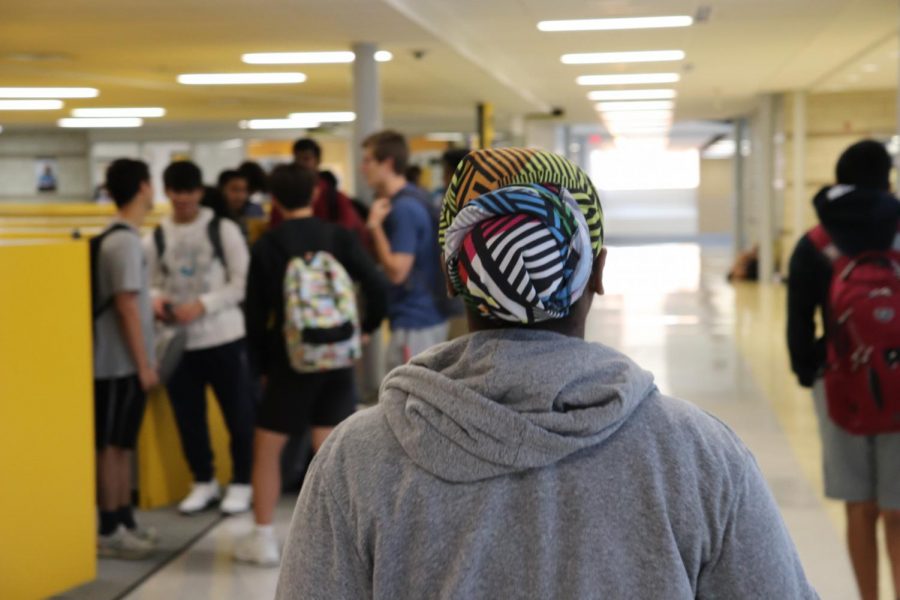Hair covering policy viewed as culturally insensitive
Deans and administrators are reminding students that hats, hoods, and head coverings are not allowed to be worn in school. The District 204 handbook states that head coverings are not allowed to be worn inside the building unless it is for a religious reason.
Over the years, durags, wave caps, scarves, and African headscarves were added to the list of head coverings that students cannot wear. However, some students think students should be allowed to wear culturally significant head coverings.
“The policy is very discriminatory and kind of censoring,“ junior Justin Campbell said.
Campbell and other students said that the policy is interfering with their ability to freely express themselves. They see the policy as unnecessary, directed towards one race, and culturally insensitive.
According to the school handbook, “Headcoverings must be removed upon entering the building.” The handbook defines head coverings as hats, hoods, headbands, rolled or unrolled bandannas, and wave caps. Religious head coverings are exempt from this policy.
Dean Kim McElroy cites student safety for the reason that head coverings are not allowed.
“We need to be able to identify your entire head and your entire face at all times. This is for your safety, protection of the staff and the school,” McElroy said.
Professional etiquette is another reason why hats are not permitted in school. Principal Dr. Darrell Echols explained that taking off hats and hoods in a building is an old custom, and many schools still follow through with the rules.
”It was an old custom in which is attached to chivalry. It has always been a policy in school buildings,” Echols said.
Hair and identity play a big role in African-American culture. African-American men and women wear durags and wave caps to achieve a hairstyle.
“It’s a cultural thing. We wear our headscarves and head wraps to keep our hair in order. It ties to ourselves and to where we are from,” Campbell said.
Some students believe that the policy and race tie together in a negative way.
“They associate durags with negatives, and that’s why we can’t wear them, but in reality it’s to get a hairstyle,” junior Tia Stewart said.
Dr. Echols has been receiving the feedback on the issue at hand and he doesn’t see it nor does he want others to see it as a race thing. “This is not a black or white thing,” said Echols. “This is something that has been customary in schools and in government buildings in general.”




Lil Tecca • Sep 24, 2019 at 7:36 pm
Amen Brother
KJG • Sep 11, 2019 at 5:57 pm
Great job!!! This is very insightful.
There are such laws called Tignon laws that support this article.
According to research, “ This headdress was the result of sumptuary laws passed in 1786 under the administration of Governor Esteban Rodriguez Miró. Called the tignon laws, they prescribed and enforced appropriate public dress for female in society.”
According to Historian Virginia M. Gould, wrote the law thought it would control women “who had become too light skinned or who dressed too elegantly, or who, in reality, competed too freely with white women for status and thus threatened the social order.”[2]
Whereas, at one point Afro- Creole/Afro American women were discriminated against because of they wearing headwraps in the workplace. Currently, there are policies and laws that support wearing headwear,(maybe not dorags or wave caps). However, the can be wrapped in many ways, and it was and is worn in a different way by every woman.
This article created controversy and enlightenment on what African Americans are experiencing in school. It identified an opportunity for improvement. Well done!!
E • Sep 11, 2019 at 10:57 am
On Jah, VOA!
VOA • Sep 10, 2019 at 6:24 pm
Dr.Echols is right. stop bringing race into every single argument. this literally has nothing to do with anyones race it’s a school security thing. I’m sorry to say no your hats are not an exception to everyone else’s and saying Durags and Wave caps should be allowed because its cultural identity is a laughable idea. It has always been proper manners to remove your hat in a building and it’s not discrimination to hold everyone to a polite and proper standard. In fact you even saying that your hats should be allowed is literally giving one group special privileges and putting them before everyone else. So not only is this laughable its now also hypocritical. Don’t use supposed “Discrimination” as an excuse to try to give yourself advantages in society. It’s wrong and it’s unfair to everyone else.
PS. Dont ever let anyone silence your voice by telling you you’re discriminating or being insensitive. Facts don’t care about your feelings
Me Myself • Feb 18, 2023 at 5:54 pm
There is no security reason for this. Head wraps does not hide ones identi cover a whole person. It’s no different than someone with long hair, a certain styled hair, or an afro. It is just plain discrimination. There are only certain groups of people who culturally wear head wraps. Head wraps are not like hats. Wearing a head wrap isn’t special treatment, privilege, or putting another group before anyone else. All people are not made exactly equal. Black hair is a lot different from any other races hair. So it’s taken care of differently.
Clarification • Sep 10, 2019 at 4:24 pm
Are (some) non-religious headcoverings allowed or not? As the woman in the picture is wearing a headcovering in school, I was confused.